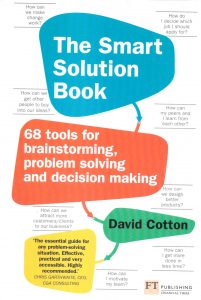The one-sentence summary
There are many tools that help with brainstorming, problem solving and decision making.
Can’t be bothered to read it? Too much screen time lately? Listen to the 5-minute podcast.
WHAT THE BOOK SAYS 
- This book contains 68 tools for brainstorming, problem solving and decision making. As working life becomes more complex, we are increasingly faced with problems that may at first seem insoluble. But whatever their size, there are a lot of techniques you can use to solve them.
- The book explains each technique, when and how to use them, and their strengths and limitations. Some are quick fixes which can be used when working alone. Others are large scale and can be used with groups of 100 people or more. You can use them separately or in combination with each other. They are especially useful to help you:
- Frame problems so they can be solved
- Find a solution to even the most intractable problem
- Enjoy the process of problem solving, whether alone or in collaboration with others
- Become more creative in your thinking so that, over time, solutions begin to present themselves
- It also explains how to overcome barriers to problem solving, preparation needs, and then each technique in turn.
WHAT’S GOOD ABOUT IT
- It is impossible to summarise 68 tools without reproducing the entire book, but some that may be of interest include:
- Force-Field Analysis: a pair of lists looking at forces that will help change, and the barriers against it
- Reverse brainstorming: focuses on how to create the problem as a way to fixing it
- Head/heart-push/pull: allows you to view the solution to a problem or decision from all angles so that you can communicate it more effectively
- Ishikawa fishbone diagrams: allow you to see every possible cause contributing to a particular result by adding more and more sub-points
- Who else has solved this problem?
- Future shock: if we continue to do X, what will be the result N weeks/months/years from now?
WHAT YOU HAVE TO WATCH
- Many of the techniques could be better explained, and faster, with diagrams rather than words.
